#kazuo takahashi
Text

Illus. Kazuki Takahashi
1K notes
·
View notes
Video
in case anyone was wondering about the kazuki takahashi house tour: this is the video. i tracked it down to share with all of you. in here, he shows off his home and studio, where he has entire shrine dedicated to yugioh merch, in addition to other various interests such as horror movies, marvel comic books, and other mangaka’s work. in his studio, he has the original yugioh manga and seems fairly proud of the work he’s created. he still had the original inkings he’d created.
takahashi was a lover of games, and i’d like to think having a hand in creating one of the biggest trading card games in the entire world is a legacy that a such a game lover would take pride in. takahashi clearly enjoyed and loved the series he created, and the loss of him is devastating. thank you, takahashi, thank you. your work inspired me to create, and i am indebted to the work you did that shaped my childhood and me as a person. this is a sentiment echoed by millions right now.
3K notes
·
View notes
Text
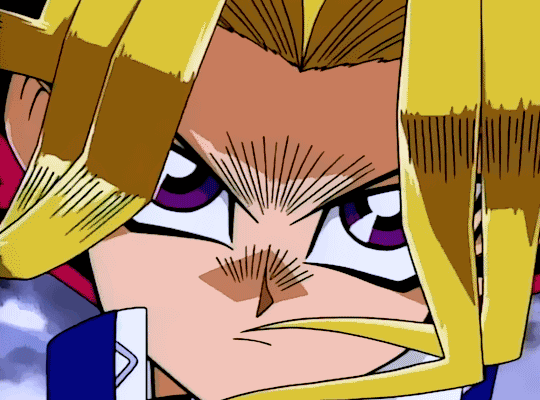
Yu-Gi-Oh!
#Yu-Gi-Oh!#card game#mutou yugi#millennium puzzle#yu gi oh cards#manga#anime#egyptian#Dark Yugi#Joey Wheeler#Téa Gardner#Tristan Taylor#Ryo Bakura#Seto Kaiba#dark magician#pharoah#exodia#curse of dragon#feral imp#Gaia The Fierce Knigh#summoned skull#red eyes black dragon#blue eyes white dragon#celtic guardian#Japanese#japan#Kazuo Takahashi#90s#1998#tabletop
38 notes
·
View notes
Link
BREAKING: Kazuki Takahashi, author of the popular manga series "Yu-Gi-Oh," has been found dead, NHK reports. He was 60. "Yu-Gi-Oh!" creator Kazuki Takahashi was discovered dead off the coast of Nago, Okinawa on July 6 at 10:30 AM. He was found wearing snorkeling equipment.
#kazuo takahashi#Yu-Gi-Oh#GX#YuGiOh GX#5Ds#YuGiOh 5Ds#Zexal#YuGiOh Zexal#Arc V#YuGiOh Arc V#Duel Monsters#YuGiOh Duel Monsters#VRAINS#YuGiOh Vrains#Go Rush#YuGiOh Go Rush
19 notes
·
View notes
Text
Author of manga 'Yu-Gi-Oh!' Kazuki Takahashi found dead in Okinawa

Kazuki Takahashi, the creator of the international smash hit manga and trading card game Yu-Gi-Oh!, was found dead in Okinawa, the Japan Coast Guard said Thursday. He was 60.
His body was discovered Wednesday floating off the coast of Nago in the southern prefecture. Takahashi was traveling alone in Nago, a popular vacation destination, and had apparently been snorkeling when he died from unknown causes, a coast guard spokesperson said.
Kazuo Takahashi was born Oct. 4, 1961, and began working as a manga artist in the early 1980s. But it was not until 1996 that he began his rise to international fame with the story of a spiky-haired boy who challenges his enemies to duels involving magical games.
The story started as a one-off but ended up running for nearly eight years in the pages of the popular Japanese boys comic magazine Weekly Shonen Jump. Along the way, it inspired movies, television shows, video games and a collectible trading card game, which rivaled Pokemon as one of Japan’s most recognizable cultural exports.
READ MORE
14 notes
·
View notes
Text
The Early Works of Kazuki Takahashi
So, here we go…
Recently i started trying to research about Kazuki Takahashi’s work from before he created Yu-Gi-Oh, since i find it pretty interesting to see how manga author’s art styles change over time and what elements reappear often in their works, but i soon learned that it is kinda hard to research about his works: not only have most of them never been released again anywhere after they were first published, but there is also not a lot of informations and pictures of them online.
That being said, I did find a lot of things during my research, including a lot of stuff I don't think has even been translated from japanese, so I'm putting them here for more people to see!
BIG WARNING THOUGH: I do not speak japanese, and most of this information was found translating with Google Translator and DeepL, with me joining them up and fixing some grammatical errors, but there might be some big translation mistakes that i didn’t catch, so if you know japanese and sees that something is wrong please inform me in on reblogs; i will put all my sources here to make it easier too.
- The Hajime Miyabi days
In his earlier works, Kazuki Takahashi submitted his stories by the pen name Hajime Miyabi, so this section is named after this first name.
His first published work was a one-shot for the Shogakukan's Weekly Shōnen Sunday magazine in 1981, and was named Ing! Love Ball; it was made for Shogakukan Newcomer Comic Awards and won first prize! The only picture of it I could find was the cover right here:
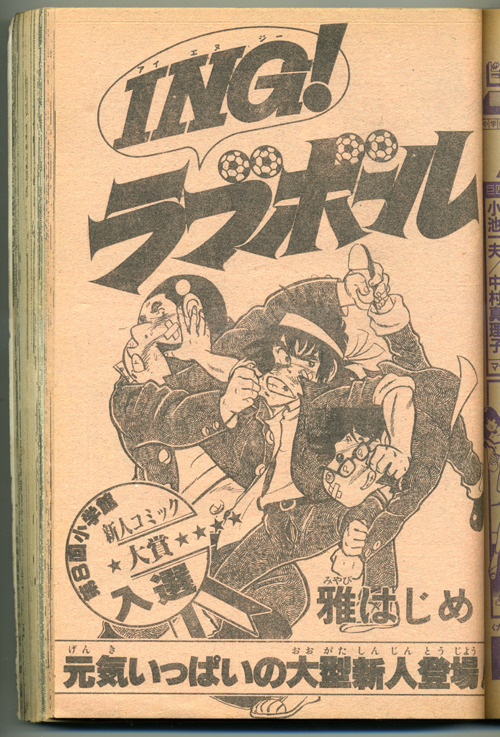
I also found this site called Kazuki's Elements and Words, which ended up being essential to this research since it has interviews, synopsis and little descriptions of all of his works! So thanks to it, we get some information about it: There are synopsis to all works on the front page of the site, and here’s the one for this manga: Three guys who love cute girls target a heroine who has a boy crush on her. Knowing her pure heart, they decide to support her, but the story goes that students from another school who target her break in and wreak havoc.
There’s also some Story Previews for this one, that say: A trio of unattractive/unpopular high school students cause havoc at their school! Three guys are always getting dumped. This time, they make a fierce attack on the female manager of the soccer club. However, the girl has a secret crush on the captain of the soccer team. And since there is another rival besides the three of them, they are in big trouble.
Since this won first place, there are reviews of it by a bunch of famous manga authors, like Leiji Matsumoto and Fujiko Fujio: many of them complimented the love story, but the art was criticized for being hard to follow and messy, and the characters were considered shallow.
His second work was Ano Ko ni Scramble (Scramble for that girl), a one-shot from June, 1982. I could not find a picture for this one, so here’s a synopsis: Dan fell in love with Rio at first sight. The story is about a heroine who doesn't really want to be an idol, and who puts her body on the line to rescue Rio. Seems to be a romance drama.
According to the site, the main guy's name is Gojo Dan (he is described as being “hard-edged”) and the main girl is called Kisaragi Rio; there’s also a dog named Koro. The owner of the site complimented this one for being very sentimental, and also commented: There were many scenes that come to mind for Yu-Gi-Oh! fans, such as the handkerchief with tear marks on it and the episode where the dog bites the buttocks… I’m not sure what he means by that to be honest.
His next work was Kyogaku Sensen SOS!! (Co-educational front SOS!), another one-shot from 1982. Found a cover here:

Synopsis is: A boys' school and a girls' school decide to merge, and the hero and heroine team up to prevent it! In the end, the hero and heroine are unable to prevent the merger, but love buds between the two.
The site says that it is a romantic comedy,that the main dude's name is Yuya Hitoyoshi and the lady is Chiharu Kazama. This Yuya is described as having selfish and passionate beliefs. Also found this blog from a Yu-Gi-Oh fan that read both this manga and the next, having this to say about this one: A love story. The content is so hot that even I blush when I read it.The heroine is cute!
(BTW I tried researching a bit, and I'm unsure if the “hot content” part is saying that the story is sexy, or if it is sentimental… who knows, maybe it’s both)
Next we have Yu Yua Yu, a one-shot from the end of 1982. This one I could only find a picture on this video by youtube channel Yaku Mitsuru's Secret Treasure House, so sorry by the stuff over the picture:

Synopsis is: Isamu lives with his mother and sister. The mother is a detective who loves motorcycles and Magnum. This is a heartwarming story in which the affection between parent and child deepens through the case.
Main character seems to be a guy named Isamu Uesugi, the mother is called Yu Uesugi and the sister is named Yua Uesugi, and she’s apparently older than him. Apparently a point of conflict in the story is the mother being very busy with work and the son wanting to spend time and get pampered by her. Both the owner of the site and that blog post praised this one for its sentimental moments, and the parent-child dynamic.
This one was his last work to be published in Weekly Shonen Sunday; from 1983, it’s a one-shot called Hajimemashite Ran Desu!! (Nice to meet you, I'm Ran!). I found a cover here:

Synopsis is: When a mysterious teacher wearing a gakuran arrives at a new school, he falls in love at first sight with a beautiful teacher. Her rival is the gym teacher, Mr. Tsukinowa. This is a story of a heated love battle between teachers.
Some story elements from the site: the main guy is called Rindo Ran, and was created to be an ideal teacher, being really nice and cool; his love interest is named Mii Aima, and is a music teacher, and she has a younger brother named Hayal Aima, who is also very cool apparently. The owner of the site mentions that the story being focused on teachers was pretty rare and refreshing, but the main character acts pretty childish.
- The Kazuo Takahashi days
Now we move to the next era of Takahashi’s work, where he started to use his real name in his manga, Kazuo Takahashi (yeah, Kazuki is not his real name!). His first work under this name was also his first serialized work: Go-Q-Choji Ikkiman, released on Kodansha's Weekly Shōnen Magazine in 1986; that being said, it was not an original creation of his, but an adaptation of an anime of the same name. This one actually has a lot of pictures online, starting with some cover pictures:

Synopsis is: A story about Ikki Sawamura, a.k.a. Ikki Man, who saves the earth from extinction by playing "Battle Ball," a sport similar to baseball. Myanimelist above also mentions that there are aliens on this, and that Ikki himself is an alien… so this is pretty different from his previous down-to-earth romance stuff.
The site has two pages about it, and says that having the anime and manga being made at the same time made this a “tightrope walking project”, but they still enjoyed the manga on it’s own right, especially because of the development of the characters, like the main character Ikki and his rival Samson, who they find one of Takahashi’s best characters (maybe because of his appearance being attractive?? the translator is kinda weird on this part).
Here’s some pictures of the interior (i believe Samson is the buff guy in that second picture). (sources 1, 2, 3, 4, 5, 6, 7)






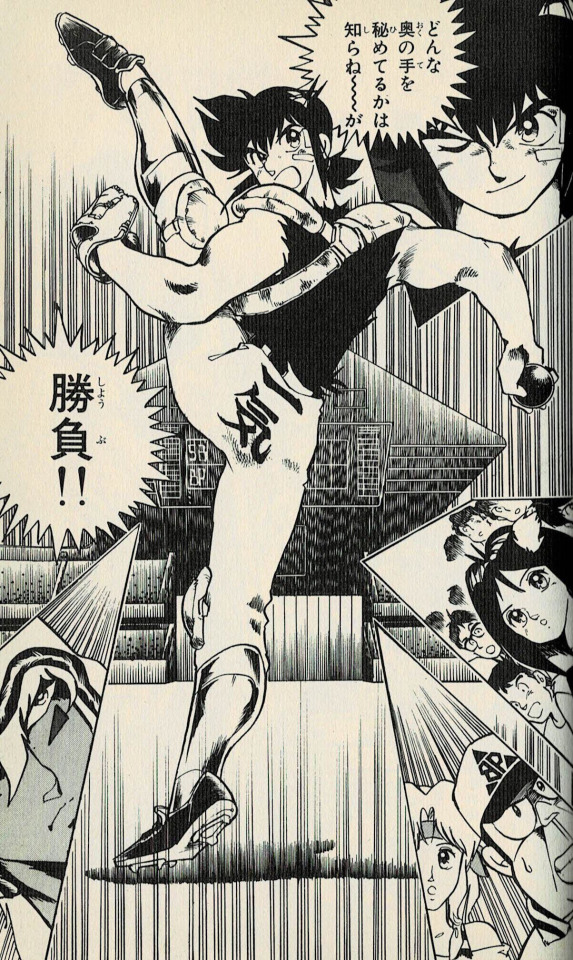

His next work was the first of his manga to be released in 1990 on Shueisha's Weekly Shōnen Jump, where all of his future manga would be published; it was called Tokio no Taka (Eagle of the King of the Flame? this title is complicated to translate). Cover from this Twitter post:

Synopsis is: A story about cool people fighting for justice and leaving for the wilderness in the end… Which is kinda vague, and there’s not a lot of information on the site besides some comments that it is more serious than his previous and later works, how it was clearly inspired by Jojo's Bizarre Adventure and that it’s page count was impressive. We do have an interior picture, and one photo that shows a little interview that Takahashi did, with a cute doodle of himself. (Sources 1 is that twitter post, 2 is here). This is also the only one-shot to be re-released after its first publishing, on an issue of his next serialized work.
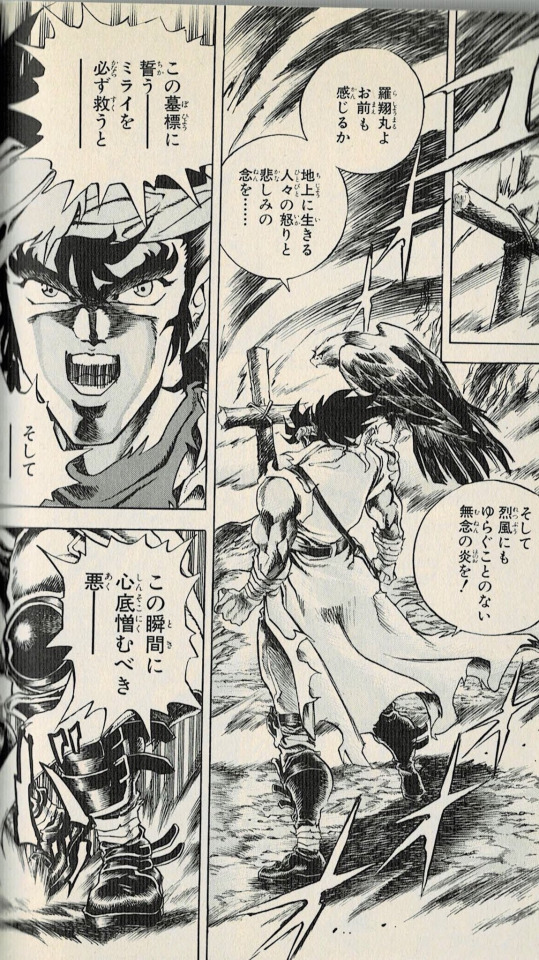

His next work was a one-shot called Battle Mind, from 1991; we have only a cover for this one, but I find it very interesting, since the design of the lady is very similar to Tea/Anzu, especially that hairstyle, and her clothes kinda look like what she wore in Death T!

Synopsis is: A story about a boy whose homeland is invaded by a dictator, who awakens with supernatural powers, fights alongside resisters, and drives out the invader. According to the site, the hero's name is Kurenai Shinku and the lady who looks like Tea is "Lime". Also, the page mentions that Takahashi talks a lot about a guy named Antonio Inoki on this, a wrestler that notably inspired that face that Joey makes a lot in the anime. At first I thought he might have helped in some way in this, but reading better I now believe it was just Takahashi fanboying because he met him before finishing the manuscript for this.
And now, his last work before Yu-Gi-Oh was serialized from 1991 until 1992, this time a completely original work of his: Tennenshoku Danji Buray (Man of Natural Color BURAY? Another one with a weird name to translate…) This one also has a ton of images, beginning with all the covers, with this main character that looks a lot like Mako Tsunami/Ryota Kajiki in some pictures:

Synopsis: Buray uses his strong body to make money as a "hit man". His reason for making dangerous money is to support the orphanage where he grew up. However, the main reason is to attract the attention of Ms. Ruriko, who runs the orphanage.... This moving film follows Burai, who thinks only of himself, as he grows into a full-fledged man through the lives of the people he encounters through professional wrestling. Yeah, Takahashi loved wrestling, if this and the previous entry didn't tell you.
The site has three different pages for the Buray manga, and the second one is the most interesting for me: it shows that during the manga’s run, they released a survey asking the readers some questions about the manga, like what they thought about the art, the main character, the plot, and most interesting of all, what they wished to happen next (though according to the site’s owner, all options eventually happened in the story). Here are the options given:

And now we have the images from the interior of the manga, and they are fascinating for me for how different they are from the YGO artstyle, yet you still can find some familiar things; these older men from pictures 4 and 5 and some of the more expressive faces are very YGO, for example! (sources 1, 2, 3, 4, 5)



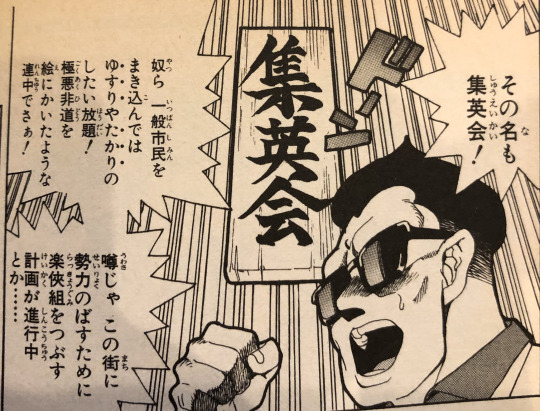





- Kazuki Takahashi era, AKA Our Conclusion
A few years after Buray, in September of 1996, Kazuo would take the pen name Kazuki Takahashi and create Yu-Gi-Oh for Weekly Shonen Jump, which is where this research ends. His work from after YGO is a lot easier to find online, so I will not talk about it in here, but i think that seeing how much his artstyle changed over time:
Looking after pictures of those first one-shots, I saw that a lot of the covers for Weekly Shōnen Sunday from around that time had something related to Urusei Yatsura on it, and i’m guessing his manga were trying to go for that niche, with very a very rounded artstyle and romance and comedy as a big element. After he did Go-Q-Choji Ikkiman, which probably had to follow the look that the anime already had, he seemed to try a more Jojo’s Bizarre Adventure/Fist of the North Star with Tokio no Taka and Buray for some extent, while Battle Mind seems to have a more traditional 80s manga style, but in all of these you can see some elements that will be seen again in Yu-Gi-Oh beginning to appear (like those buff men from Ikkiman, Tokio no Taka and BURAY kinda reminding me of Ushiou and Goro Inogashira).
And then when you get to YGO, his style begins with traces of those previous works, but develops to become a lot more unique, a way more stylized look full of pointy chins and big hair; it was honestly super cool to see how much it changed from that beginning with his weird one-shot that somehow won a first prize in a Newcomers competition.
I’m not very good at finishing essays to be honest, so i’ll end this by putting a last picture in here: one of his way later works from 2020, coming from this account that used to translate his instagram posts:

Thanks for reading it!
#long post#kazuki takahashi#yugioh#ygo#yu-gi-oh!#kazuo takahashi#manga#shonen jump#vintage#takahashi kazuki#weekly shonen sunday#weekly shonen jump#seekerbr's things
44 notes
·
View notes
Text
Yu-Gi-Oh! Creator Takahashi Kazuki has Died
Yu-Gi-Oh! Creator Takahashi Kazuki has Died #manga #yugioh
2022 looks to be a year of heavy loss in the comic and manga community. News broke today that Takahashi Kazuki, the creator of Yu-Gi-Oh! has been found dead. He was 60 years old.
Takahashi, whose real name is Kazuo Takahashi, was discovered floating in the water near the Okinawa Prefecture in Japan on Wednesday. He was in snorkeling gear. The cause of death is being investigated.
Takahashi…

View On WordPress
1 note
·
View note
Text
The Manga Review, 7/8/22
The Manga Review, 7/8/22
By now, if you’ve been on Twitter or Facebook, you’ve undoubtedly learned that Kazuki Takahashi died on Wednesday. Media outlets from National Public Radio to the New York Times, the Los Angeles Times, and Anime News Network have been covering the story, reporting the probable cause of death as a diving accident. Takahashi was a major force in the manga industry; his Yu-Gi-Oh! (1996-2004) spawned…

View On WordPress
0 notes
Text
Takahashi Kazuki, creador de 'Yu-Gi-Oh!', muere a los 60 años
Takahashi Kazuki, creador de ‘Yu-Gi-Oh!’, muere a los 60 años
Takahashi Kazuki, artista de manga japonés al que se le atribuye la creación de la serie de cómics “Yu-Gi-Oh”, fue encontrado muerto el miércoles. Tenía 60 años.
La emisora pública NHK informó que el cuerpo de Takahashi fue encontrado en el mar, a unos 300 metros de la costa de Nago, en la provincia de Okinawa. Informó que llevaba puesto un equipo de esnórquel en ese momento.
El cuerpo fue…

View On WordPress
0 notes
Photo
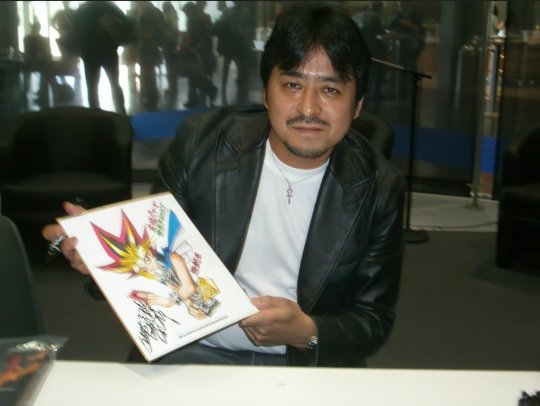
Yu-Gi-Oh! manga creator Kazuki Takahashi (real name Kazuo Takahashi) has passed away at age 60 due to an apparent diving accident.
The Coast Guard reportedly found Takahashi equipped with snorkeling gear. Both the Coast Guard and police are currently investigating the events that led up to Takahashi's death. A person on a passing boat had called Japan's maritime hotline to report an apparent body, floating 300 meters (about 1,000 feet) from the coast off the resort city of Nago, at about 10:30 a.m. on July 6, 2022.
Takahashi's Yu-Gi-Oh! manga launched an international hit franchise that continues to this day with card games, anime, toys, and newer manga series. Takahashi won Comic-Con International's Inkpot Award in July 2015. The award recognizes individuals for outstanding contributions to comics, science fiction and fantasy, film, television, animation, and fandom.
9K notes
·
View notes
Text

According to Fujimoto, Takahashi Makoto was the first to incorporate the style picture into the narrative, overlapping the image of the main character onto the other frames, in his serialized manga story Arashi o koete (Beyond the Storm, 1958). Immediately afterward, other artists, including Umezu Kazuo, Watanabe Masako, and Maki Miyako, imitated this use of the style picture. Yonezawa Yoshihiro also credits Takahashi Makoto with innovating this incorporation of the style picture into the narrative.
Why was this innovation of the full-body portrait so important for the development of visual narrative in shōjo manga? The use of style pictures and full-body portraits is one point on which critics have disparaged shōjo manga, claiming that they are nothing more than an empty display of fashion. However, as Takahashi Mizuki points out, the use of the full-body portrait was part of the way artists could encourage reader identification with the main character and vary narrative flow. More important, it was a short step from layering the style picture over the frames to creating more complex layered images that depict the characters’ emotions and private thoughts.
Fujimoto argues that because Takahashi developed his narrative style based on illustration, he was accustomed to a format in which the plot is explicated by the narration, freeing the pictures to be non-narrative; since the story is explained in the text, there is no need to show all the action in the pictures, which can instead be more decorative and emotive. The reliance on non-narrative, lyrical elements reflects the influence of jojōga illustration from prewar magazines. With this decorative style a new dimension opened in shōjo manga that allowed for the psychological complexity that came later, in the 1970s, as artists experimented with the arrangement of text and pictures to depict emotions that could not be expressed in words.
Deborah Shamoon, Passionate Friendship: The Aesthetics of Girl's Culture in Japan
42 notes
·
View notes
Text
My manga collection (October 2023)
I did a post detailing my manga collection back in 2021, but it's grown a lot since then so I figured I'd make a new post! It was also a good time to do so because we're repainting my room and while there's usually a ton of anime merch in front of the books on my shelves, now it's all been packed up. So there's a clear look at the books without me having to move anything, lol.
Anyway, without further adieu, here we go! My manga collection is largely shoujo (specifically magical girls) and horror manga.

Pet Shop of Horrors by Matsuri Akino
Pet Shop of Horrors: Tokyo by Matsuri Akino
The Clique by Yishan Li
Frozen II manga by Arina Tanemura
Dark Metro by Tokyo Calen and Yoshiken
Yokai Rental Shop by Shin Mashiba
Confidential Confessions by Reiko Momochi
Pichi Pichi Pitch (aka Mermaid Melody) by Michiko Yokote and Pink Hanamori
Magical Girl Site by Kentaro Sato
Reiko the Zombie Shop by Rei Mikamoto
Les Miserables (manga adaptation) by TszMei Lee
Nightmares for Sale by Kaoru Ohashi
Presents by Kanako Inuki
Mail by Housui Yamazaki
Dark Water by Meimu
Tale of a White Night by Tooko Miyagi
Goth by Otsuichi and Kendi Oiwa
Beautiful People by Mitsukazu Mihara
Attack on Titan: No Regrets by Gun Snark and Hikaru Suruga
In Clothes Called Fat by Moyoco Anno
A Girl on the Shore by Inio Asano
Bride of Deimos by Etsuko Ikeda and Yuuho Ashibe
Limit by Keiko Suenobu
Helter Skelter by Kyoko Okazaki
Dolls omnibus (in Japanese) by Yumiko Kawahara
Ibitsu by Haruto Ryo
A God Somewhere (Western comic) by John Arcudi and Peter Snejbjerg
Beauty (Western comic) by Hubert and Kerascoët

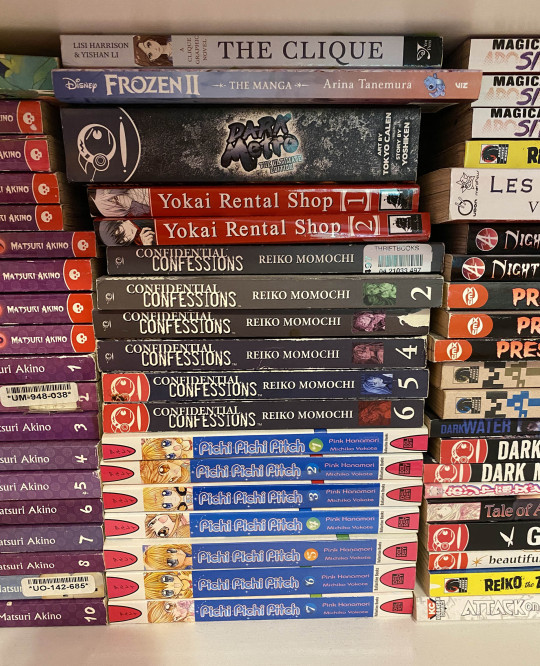

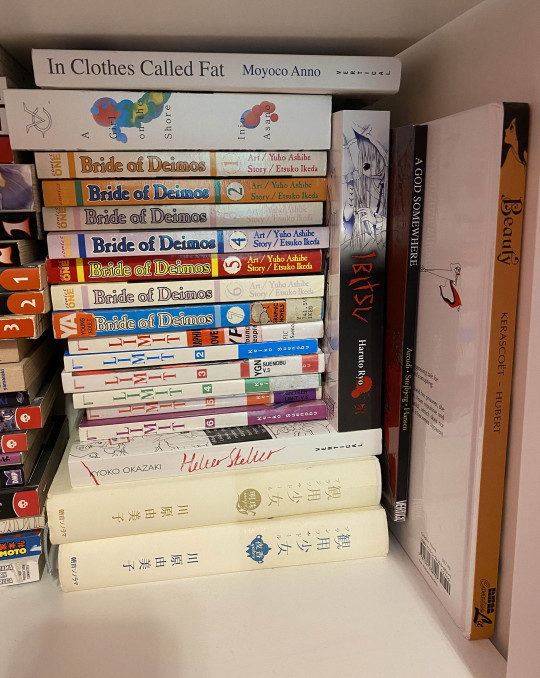
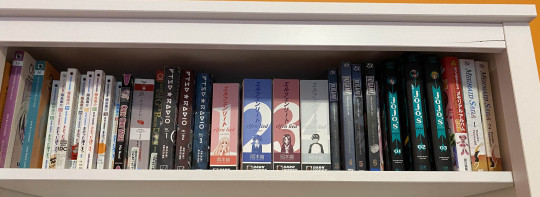
Ah! My Goddess by Kōsuke Fujishima
Only One Wish by Mia Ikumi
Higurashi When They Cry: Festival Accompanying Arc by Karin Suzuragi
Chronicles of the Grim Peddler by Lee Jeoun-A
PTSD Radio by Masaaki Nakayama
Elfen Lied by Lynn Okamoto
Ikigami: The Ultimate Limit by Motoro Mase
Happy Sugar Life by Tomiyaki Kagisora
JoJo's Bizarre Adventure: Phantom Blood by Hirohiko Araki
An Ojamajo Doremi artbook (in Japanese)
Mermaid Saga by Rumiko Takahashi
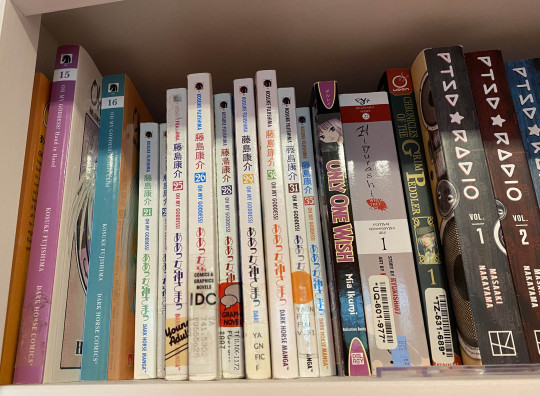
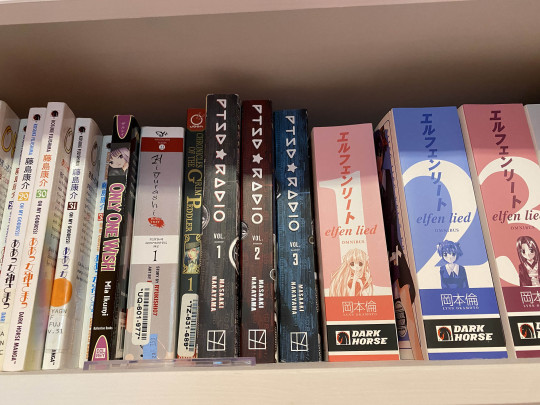

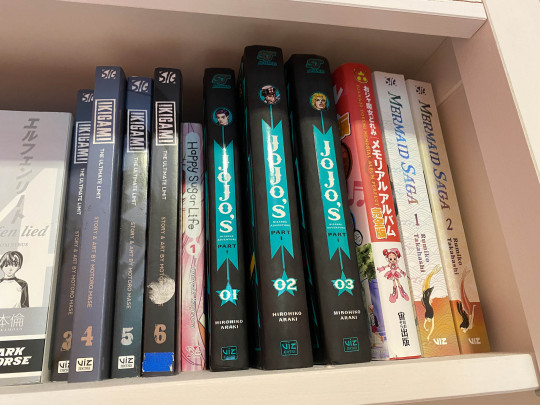

Dolls by Yumiko Kawahara
Maid-sama by Hiro Fujiwara
Franken Fran by Katsuhisa Kigitsu
Hell Girl by Miyuki Eto
Gurren Lagann by Kotaro Mori
Doll by Mitsukazu Mihara
Mantis Woman by Senno Knife
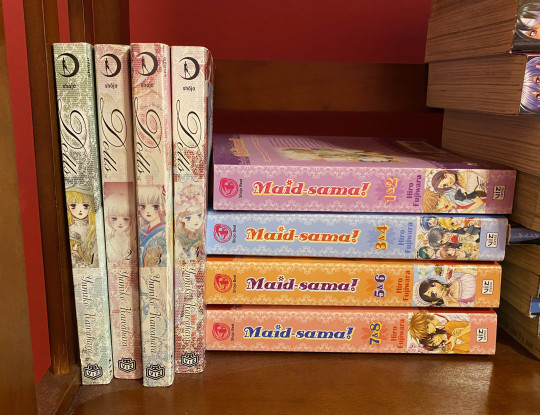
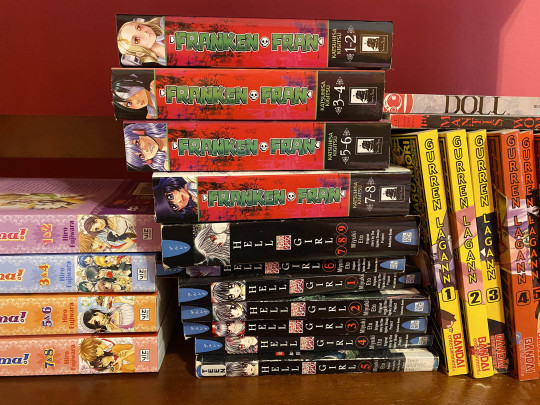
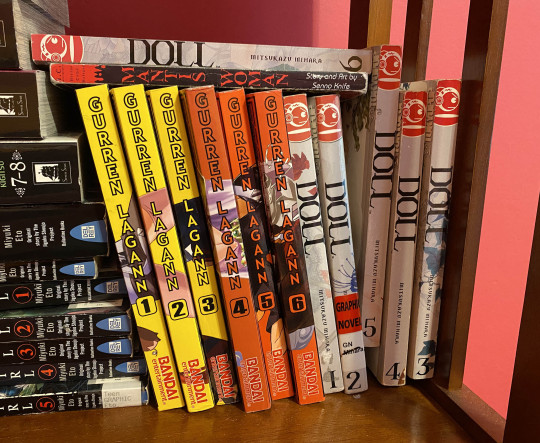
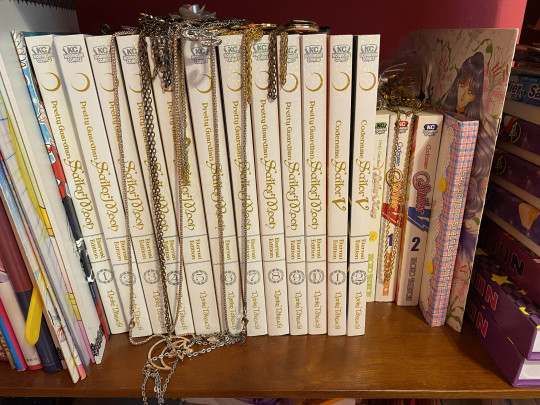
Various Sailor Moon artbooks from the anime, manga illustrations by Naoko Takeuchi, and fan artbooks
Sailor Moon Eternal Edition by Naoko Takeuchi
Sailor V Eternal Edition by Naoko Takeuchi
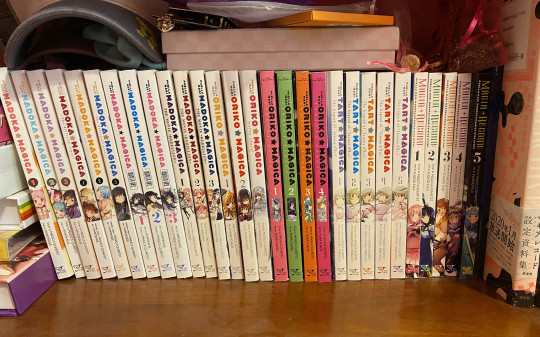
Puella Magi Madoka Magica by Hanokage
Puella Magi Madoka Magica: The Different Story by Hanokage
Puella Magi Madoka Magica: The Wraith Arc by Hanokage
Puella Magi Madoka Magica: The Rebellion Story by Hanokage
Puella Magi Oriko Magica by Kuroe Mura
Puella Magi Oriko Magica: Sadness Prayer by Kuroe Mura
Puella Magi Tart Magica by Golden Pe Done
Magia Record: Puella Magi Madoka Magica Side Story by Fuji Fujino
Assorted PMMM and Magia Record artbooks
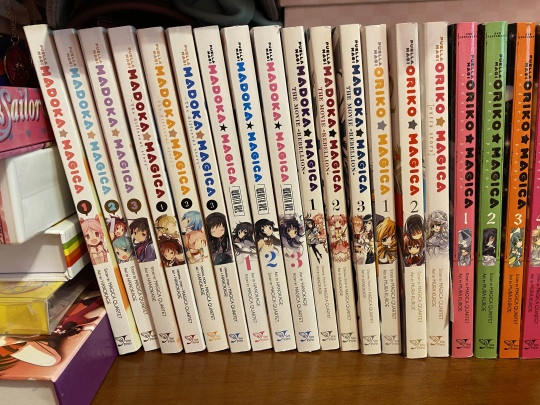
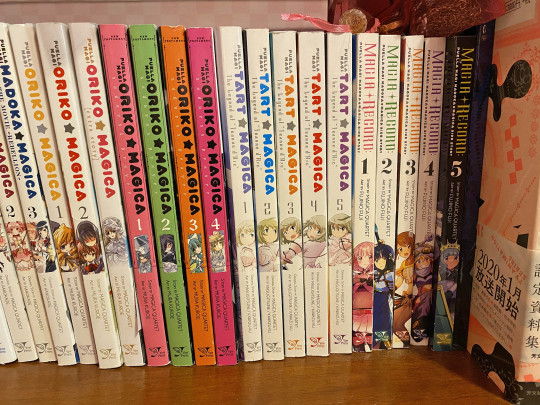
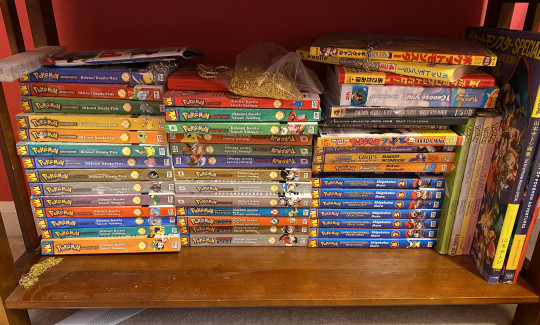
Pokemon Adventures (aka Pokemon Special) by Hidenori Kusaka and Mato/Satoshi Yamamoto. I own the complete set of the RBG, Yellow, GSC, FRLG, Emerald and HGSS arcs as well as a few volumes from the RS, DP, and Black/White arcs.
Various Pokemon 4koma (in Japanese)
Pokemon: I Choose You by Ryo Takamisaki
Phantom Thief Pokemon 7 by Miho Asada
The Rise of Darkrai by Ryo Takamisaki
Pokemon Diamond and Pearl Adventure by Shigekatsu Ihara
The Electric Tale of Pikachu by Toshihiro Ono
The Art of Pokemon Adventures by Satoshi Yamamoto (both English and Japanese versions)
Pokémon Mystery Dungeon: Ginji's Rescue Team by Makoto Mizobuchi
Pokemon Ranger and the Temple of the Sea by Makoto Mizobuchi



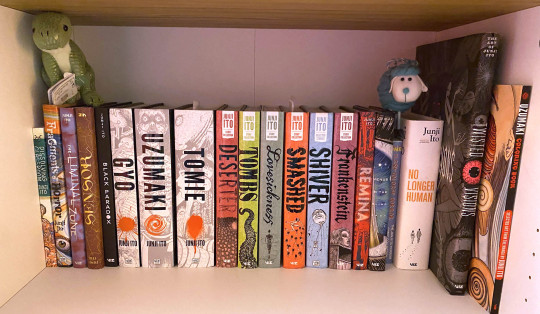
Various Junji Ito Manga:
Dissolving Classroom
Fragments of Horror
The Liminal Zone
Sensor
Black Paradox
Gyo
Uzumaki
Tomie
Deserter
Tombs
Lovesickness
Smashed
Shiver
Frankenstein
Remina
Venus in the Blind Spot
No Longer Human
Twisted Visions (artbook)
Uzumaki coloring book

Uzumaki (original printing) by Junji Ito
Museum of Terror by Junji Ito
Soichi by Junji Ito
The Drifting Classroom by Kazuo Umezu
JoJo's Bizarre Adventure: Battle Tendency by Hirohiko Araki
Orochi by Kazuo Umezu
Be Very Afraid of Kanoko Inuki! by Kanoko Inuki
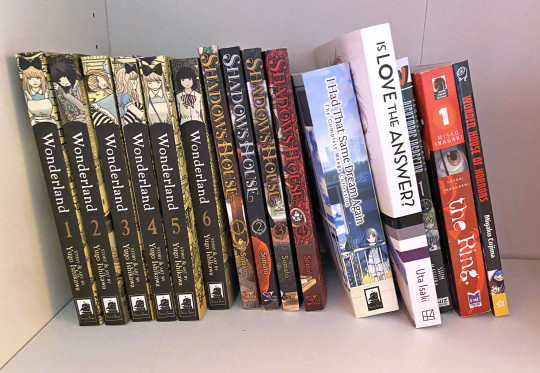
Wonderland by Yugo Ishikawa
Shadows House by Somato
I Had That Sane Dream Again by Yoru Sumino
Is Love the Answer? by Uta Isaki
Nightmare Inspector by Shin Mashiba
The Ring by Misao Inagaki
Wonder House of Horrors by Miyako Cojima
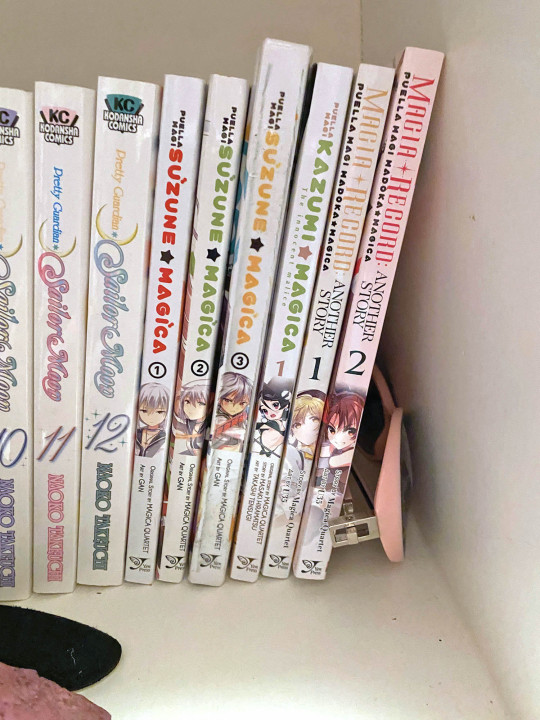
Puella Magi Suzune Magica by GAN
Puella Magi Kazumi Magica by Masaki Hiramatsu and Takashi Tensugi
Magia Record: Another Story by U35
I also have some manga in storage like Inuyasha and Kitchen Princess, but that's about it!
54 notes
·
View notes
Note
Akira Toriyama passed away March 1st of acute subdural hematoma. I don't know how to process this.
Had a friend send me a message about that and got the post up real quick, just seeing this now.
It's a big fat mess, lost Takahashi Kazuo of Yu-Gi-Oh! fame year and a half ago and now now we got Akira Toriyama man who brought DBZ into the world.
Both legends that are gonna live on through their work for a long long time though so take whatever comfort in that you can .
Back and forth with my friend we both agreed there's gonna be some sort of day of mourning in Mexico city, I think all of Latin America.
He's going to be remembered and mourned for a long time by billions of people.
8 notes
·
View notes
Photo

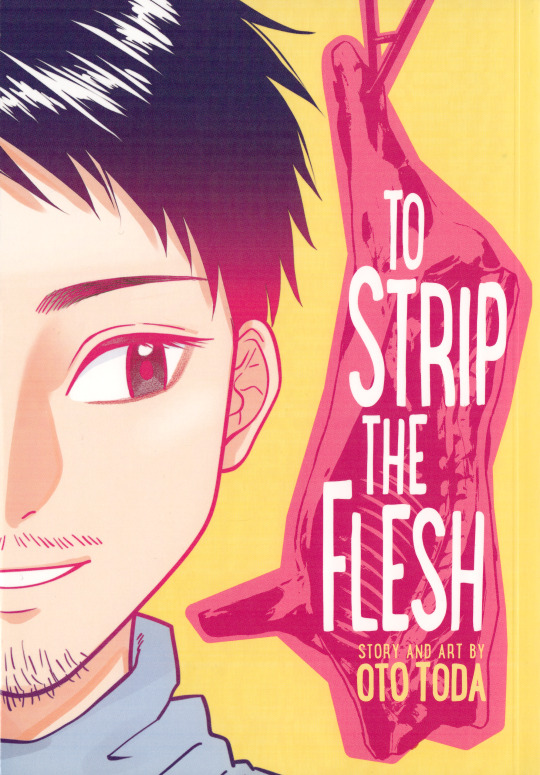

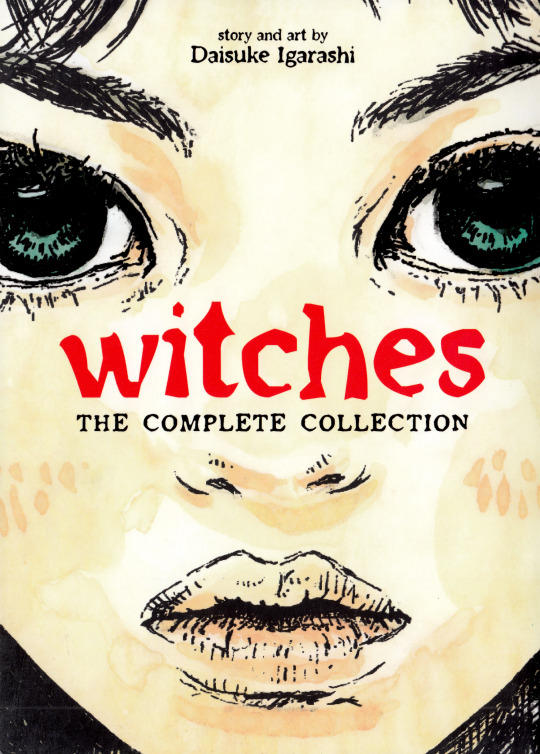




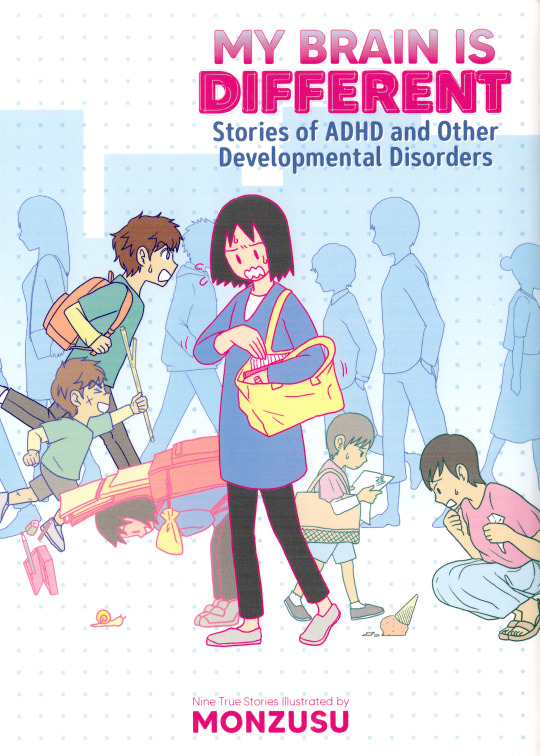
2022 YEAR ROUNDUP: FAVORITE RELEASES OF THE YEAR
Another year has passed, so here’s the much overdue yearly roundup! First is titles that were released in 2022:
Talk To My Back by Yamada Murasaki [Drawn & Quarterly, trans. Ryan Holmberg]
To Strip The Flesh by Oto Toda [Viz Media, trans. Emily Balistrieri]
Came The Mirror & Other Tales by Rumiko Takahashi [Viz Media, trans. Junko Goda]
Witches by Daisuke Igarashi [Seven Seas, trans. Kathryn Henzler]
Box of Light by Seiko Erisawa [Seven Seas, trans. Daniel Komen]
童夢 (Domu: a Child’s Dream, Otomo The Complete Works edition) by Katsuhiro Otomo [Kodansha]
Daily Report About My Witch Senpai by Maka Mochida [Seven Seas, trans. Liya Sultanova]
Orochi by Kazuo Umezz [Viz Media, trans. Jocelyne Allen]
My Brain Is Different: Stories of ADHD and Other Developmental Disorders by Monzusu [Seven Seas, trans. Ben Trethewey]
I cherish every anthology manga that makes it to english and when we got “To Strip the Flesh”, “Came the Mirror”, “Box of Light” “Witches”, and “Orochi” we truly struck gold. I’ve been waiting for Igarashi to get another shot at the english language market, and then Orochi and the announcement of the new Cat-eyed Boy editions confirmed that Umezz’s is back to stay, crossing my fingers for a major title like My Name Is Shingo or Fourteen next.
I will count Box of Light among the anthologies as the stories presented in each chapter stand so well on their own. I will never say no to a fun take on the liminal space between life and death.
Essay manga I can now say has become a regular part of the licenses American publishers hand us, and I will gladly read every single one of them. This year my favorite was by far “My Brain Is Different”. A painful but much needed collection of personal accounts from adults and their life long struggles living with autism and ADHD.
D&Q has barely missed with their alternative manga picks as well as their korean manhwa licenses. Now it appears they’re ready to showcase more women from this scene and Talk to My Back was an amazing way to follow up The Sky is Blue With a Single Cloud by Kuniko Tsurita. This simple chronicle of a housewife and her family accompanied with an impressive and detailed write-up of Murasaki’s career was a great read that I will absolutely come back to again and again.
The return of Domu was a grand and long awaited one as this series has been out of print in its native country for quite some time. This XL sized edition contained not just color pages and previously uncompiled chapter covers plus a look back on the making of the manga, including photos of the real life housing complex the story takes place in. Hoping an english edition of the same caliber will follow suit in the near future!
And Witch-Senpai is just a simple romance I found myself feeling very engaged in and was one of the first titles that came to mind when putting this list together.
40 notes
·
View notes
Text
It’s really hard, to talk about the death of a “celebrity”. Someone you admire, someone who changed your life, someone who (and not in a bad way) has no idea that you exist. Takahashi Kazuki (Kazuo) created Yu-Gi-Oh, a show, manga, and game that has shaped my life and the lives of countless people I know. Whether it’s the fond memories of childhood, a sense of humor built up from an abridged series, a persistent fascination with Egyptology, and more recently, a sense of community and excitement during and following a global pandemic, his work has undoubtedly made me the person I am today.
Deeply inherent in his works was the belief that relationships between people, the interplay and communication of your truest heart reaching out and connecting with the truest heart of your friends and your rivals alike. In a world that has often felt, especially recently, cruel and isolating, these lessons have always reminded me to seek joy, faith in myself, and belief in those around me. It’s reminded me that for every dark moment, there is still hope. For every goodbye on the horizon, there is still joy both before and after it.
Thank you, Takahashi-sensei, for all your lessons. If I’ve learned anything about walking forward after a loss, surely I’ve learned at least a little of it from you.
#ygo#yugioh#Yu-gi-oh#yu gi oh#Takahashi kazuki#duel monsters#been thinking about how to say this all day
72 notes
·
View notes